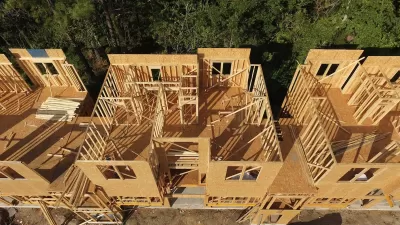Nationwide increases in housing stock since 2020 mirror post-pandemic moving patterns, with six states in the West and South accounting for half of new units.

“The United States has added almost 5 million housing units since 2020, most heavily in the South and most of them single-family homes, making a housing shortage look conquerable in much of the nation,” reports Tim Henderson for Stateline. According to Stateline analysis of Census Bureau data, six states account for 50 percent of the increase: Texas, Florida, California, North Carolina, Georgia, and Tennessee. Last year alone produced the most housing units since 2007.
Henderson notes that the pattern mirrors post-pandemic moving patterns but points out that experts say another 2 to 2.5 million units, mostly single-family homes, are needed. The US has added 1.6 million new units annually for the past two years, according to the Census Bureau data, and that pace is expected to continue.
However, while increased stock may mean cost increases could slow or stabilize, it doesn’t necessarily mean housing prices will come down, as high interest rates continue to hurt potential homebuyers and inflation drives up the cost of building materials and labor. “The Federal National Mortgage Association, known as Fannie Mae, reported last year that the typical homebuyer paid 35% of their income in mortgage payments in October, the highest since at least 2000,” writes Henderson.
States with affected by poverty and low population growth — including Rhode Island, Illinois, West Virginia, Connecticut, Alaska and New Jersey — saw the slowest housing growth, according to Stateline analysis of Census Bureau data.
FULL STORY: Housing boom in most of the US could ease shortage, but cost is still a problem

Alabama: Trump Terminates Settlements for Black Communities Harmed By Raw Sewage
Trump deemed the landmark civil rights agreement “illegal DEI and environmental justice policy.”

Planetizen Federal Action Tracker
A weekly monitor of how Trump’s orders and actions are impacting planners and planning in America.

The 120 Year Old Tiny Home Villages That Sheltered San Francisco’s Earthquake Refugees
More than a century ago, San Francisco mobilized to house thousands of residents displaced by the 1906 earthquake. Could their strategy offer a model for the present?

In Both Crashes and Crime, Public Transportation is Far Safer than Driving
Contrary to popular assumptions, public transportation has far lower crash and crime rates than automobile travel. For safer communities, improve and encourage transit travel.

Report: Zoning Reforms Should Complement Nashville’s Ambitious Transit Plan
Without reform, restrictive zoning codes will limit the impact of the city’s planned transit expansion and could exclude some of the residents who depend on transit the most.

Judge Orders Release of Frozen IRA, IIJA Funding
The decision is a victory for environmental groups who charged that freezing funds for critical infrastructure and disaster response programs caused “real and irreparable harm” to communities.
Urban Design for Planners 1: Software Tools
This six-course series explores essential urban design concepts using open source software and equips planners with the tools they need to participate fully in the urban design process.
Planning for Universal Design
Learn the tools for implementing Universal Design in planning regulations.
Clanton & Associates, Inc.
Jessamine County Fiscal Court
Institute for Housing and Urban Development Studies (IHS)
City of Grandview
Harvard GSD Executive Education
Toledo-Lucas County Plan Commissions
Salt Lake City
NYU Wagner Graduate School of Public Service





























